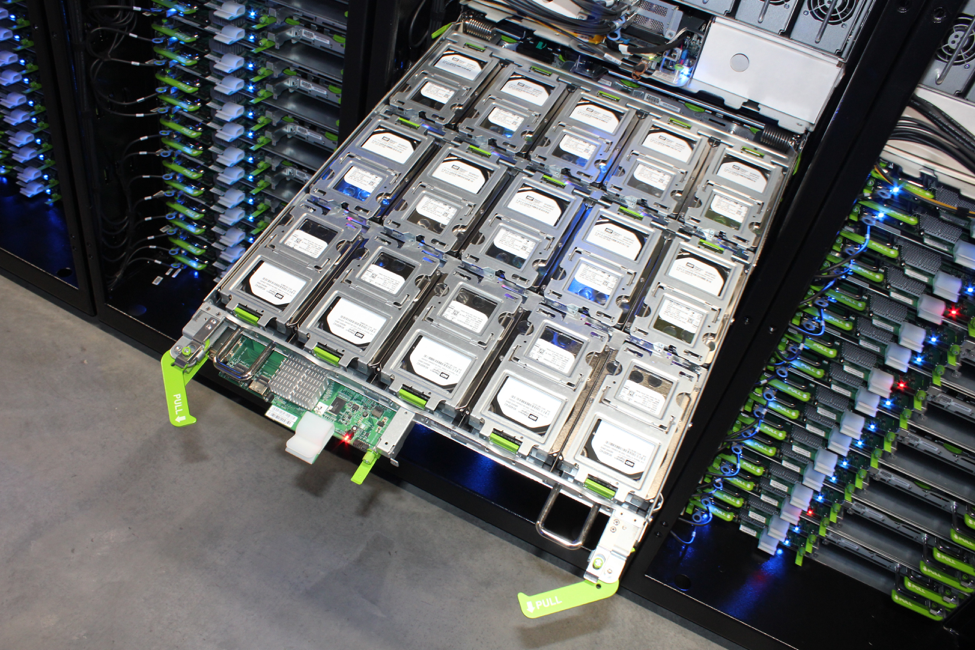Everyone these days seems to want to operate like the massive scale data center operators or at least capitalize on the economies of scale they created in their wake. It’s a familiar trickle-down economics idea that sounds great on paper but doesn’t always operationalize well for the rest of the world. In the case of data storage, we will walk through comparisons between an open source design vs. one that is commercially available for everyone and not just massive scale data center operators.

In 2013 Facebook contributed to their Open Compute Project a hardware design called Open Vault for high volume data storage. This is a 2RU dual-tray modular disk enclosure supporting up to 15 3.5” HDDs per tray and designed initially as JBOD storage. Products like this are great for serviceability where hardware design can have immediate value to ongoing operations.

It got me thinking to take a little field trip to our own Data Center in San Jose to see our products in action. Our Cisco IT department was gracious enough to let me in for a tour and help scout out a pair of S3260 storage servers used to test data protection software for our corporate backups.
This is exactly what I was hoping for to show you the S3260 storage server in comparison to the Open Vault product by Facebook. As you can see both products were designed with many of the same serviceability concepts in mind for hosting large volumes of data.

The entire chassis is designed to be serviced without the need for tools. I would even go so far to say that you can easily get into this box without reading an installation guide as it’s latches and neon green spring loaded buttons are very intuitively designed. To gain initial access to the box you simply flip two latches on the front left and right handles to unlock and pull out the enclosure from it’s rack.

Doors on the top open with easy to use latches exposing 56 vertically oriented data drive slots which can host SSD or SAS drives. Drive carrier adapters are removed by pressing a single release button and can accommodate either a 2.5” small form factor drive or a 3.5” large form factor drive.

Outside of serviceability and raw storage attributes, you might want to also compare the efficiency of the hardware design itself. In the chart below you can see we were able to design a product within a 4RU footprint that supports the same number of data drives as two Open Vault products, but squeezed into a much smaller form factor. This was achieved with a simple design decision to vertically orient the drives vs. laying them flat in simple carrier trays.

You might look at the chart and say “that’s not a big difference”. But it is a big difference if one or two inches prevents you from inserting your new chassis into a rack due to width or close and secure a door due to depth. Although this isn’t a problem for Facebook or Open Compute adopters. Open Vault was designed to go inside their custom designed Open Rack system that is wider and deeper than standard racks to accommodate their own custom designed servers, storage and networking gear.
For traditional IT equipment manufacturers, we need to design products that work for everybody. Meaning we design within the constraints of the four-post EIA rack specification described in section 1 of the ANSI/EIA-310-D-1992 industry standard. These type of racks have been around for decades and are still prominently used in majority of our customer’s data centers hence the need to design products optimized for them.

I did mention earlier the S3260 supports 56 vertically oriented data drives. One of the cool things about this box is it’s ability to convert into different personality modes depending on your specific need. Single or dual-server nodes, JBOD or RAID, more processing power or storage capacity, cache acceleration or unified storage connectivity, it’s really about versatility. To put it simply, this isn’t your father’s JBOD or legacy storage server.
To achieve parity with Open Vault on capacity, we can convert to a single node system by adding a drive expander giving an additional four data drive slots totaling 60 data drives or 600 Terabytes of raw storage with our new 10TB drives. The S3260 is pretty beefy as a single box but you can also connect up to ten S3260s to redundant 40 Gigabyte Fabric Interconnects for up to 6 Petabytes of raw storage per rack.

In this configuration, it would take two Open Vault’s to support the same amount of drives. But as highlighted in the chart above, the S3260 requires much less space and is well within the constraints of an industry standard 19 inch rack like our R-Series Data Center Racks. And better yet, each server node is a two-socket architecture with processor options ranging from 8 to 18 cores each, giving customers greater flexibility to not only store data but to also run data intensive workloads.

While both approaches are cool they each have very specific intent. In our intent, we look to provide innovative products and solutions catering to the broadest range of customers. We also look to help solve problems not just for homogenous application environments but the more challenging goal of solving problems for multi-generational heterogeneous application environments.
If you are interested in taking a virtual field trip and seeing a S3260 in action, check out our 3D model or reach out to a Cisco Partner for more information.
If you liked this blog please stay tuned for more on data center storage solutions at Cisco and be sure to follow me on Twitter.
Do we have use-cases in terms of specific customer solutions deployed with these solutions
Definitely! It’s popular with cloud service providers and often used for active archive of video surveillance data in retail, universities, hospitals and smart city initiatives. We are also seeing great adoption for S-Series as an enterprise class backup target with our partners Commvault and Veeam.
Here are a couple public links to customer references
Cirrity
https://www.youtube.com/watch?v=9W3SnmgGgtU
GreenCloud
https://www.youtube.com/watch?v=9h1Hgdiqpl4&t=1s
Xerox and Cirrity
http://www.cisco.com/c/m/en_us/training-events/events-webinars/webinars/ucs-s-series-storage-servers.html